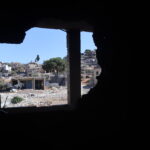In the age of Oppenheimer, nuclear weapons didn’t have much to do with computers. And, for a long time, most nukes were running on 1970s-era floppy disk systems. But as technology has advanced the US — and all the other nuclear weapons states — have started putting military communications, early warning systems, and even control of nuclear missiles themselves online. So, in this episode, we ask, “Could our nuclear weapons systems… be hacked?”
We talk to researchers, policy experts, a top UN official, and a hacker about how a nuclear cyber attack might go down. And what we can do to stop it.
Guests:
Matt Korda, Senior Research Fellow, Nuclear Information Project; Allison Pytlak, Program Lead of the Cyber Program at the Stimson Center; Page Stoutland, Consultant at the Nuclear Threat Initiative, Maddie Stone, Security Researcher at Google Project Zero; Izumi Nakamitsu, Under-Secretary-General for Disarmament Affairs at the UN Office for Disarmament Affairs
Additional Resources:
Flying Under The Radar: A Missile Accident In South Asia, Federation of American Scientists
Addressing Cyber-Nuclear Security Threats, Nuclear Threat Initiative
Glitch disrupts Air Force nuke communications, NBC News
A ‘Worst Nightmare’ Cyberattack: The Untold Story Of The SolarWinds Hack, NPR
The Failsafe Review, Nuclear Threat Initiative
Transcript:
[News Coverage in Urdu]MATT KORDA: In the springtime of 2022, something very unprecedented happened… or at least something that had not happened in a long time. Which was a nuclear armed country accidentally launching a missile into another nuclear armed country’s territory.
LAICIE HEELEY: This is Matt Korda. He’s a senior researcher for the Nuclear Information Project at the Federation of American Scientists.
MATT: By all accounts, India was in the midst of some kind of demonstration, or exercise, and a missile accidentally got launched somehow.
LAICIE: The missile he’s talking about? It started its journey in Northwestern India near a major Indian air force base.
MATT: So it then traveled in a southwesterly direction, at a pretty high speed, for about a hundred kilometers.
[Missile sounds]LAICIE: It was passing over Indian territory at this point. Whizzing by unsuspecting commercial air traffic, hurtling over farmland and small towns, and making its way toward the vast Rajasthani desert.
MATT: And then it suddenly turned northwest and crossed into the India Pakistan border.
[Missile sounds]LAICIE: For several minutes it flew deeper and deeper into Pakistani territory. It wasn’t armed with a nuclear warhead but Pakistan didn’t know that.
Pakistan scrambled its jets. And India…said nothing.
MATT: And then it crashed near the Pakistani town of Mian Channu and very luckily, it didn’t crash into any buildings or any people.
LAICIE: Thankfully no one was hurt. And Pakistan didn’t retaliate.
TARIQ ZIA (Director General Public Relations for the Pakistan Air Force): Pakistan strongly protests this flagrant violation…
LAICIE: But they were pretty mad.
TARIQ: …and cautions against recurrence of any such incident in future.”
LAICIE: So, they demanded answers for two full days until India finally made a statement.
MATT: The first thing that India said about this was that it was a technical error with the missile. Which they then very quickly changed that story and it was attributed to human error and then several officers were discharged.
LAICIE: Human error and technical malfunction are two sides of the same coin when it comes to nuclear security. And, especially from the outside, it can be hard to tell which one is at fault.
MATT: According to Indian defense sources, a series of software locks would’ve had to have been bypassed and two manual keys would’ve had to be inserted in order to initiate that launch countdown.
LAICIE: The fact that this didn’t start a nuclear war? It was just lucky timing.
MATT: India and Pakistan were not actively in a conflict at the time. But that certainly wasn’t always the case, right? Like in 2019, 2021, there have been instances in which people have died on both sides of that conflict. Right? I think we got very lucky that this was during a period of relative peace time.
It’s a wild example of what can happen when you have these human error bits that inject themselves into an ongoing kind of simmering nuclear crisis.
LAICIE: We don’t know for sure what happened the day India fired a missile at Pakistan out of the blue. Exactly who did what wrong. Or if there was really a problem with the missile or the software involved in its launch.
But the incident raises at least a few big questions. One massive one? How hard would it be for an enemy to mess with these weapons systems on purpose?
And… could our very own, American, nuclear weapons be hacked?
I’m Laicie Heeley. And this is Things That Go Boom.
[music transition]LAICIE: The short answer is yes, nuclear weapons, nuclear command, control, and communications… they all use computers and so they are, indeed, all vulnerable to cyber attacks.
But to understand how that might work, we need to take a little tour through history.
ALLISON: My name is Alison Pytlak and I am the program lead of the cyber program at The Stimson Center.
LAICIE: Allison has been working on cyber security and accountability issues for about a decade.
So we asked her when it was that hacking really started to feel like a threat to nuclear security.
She told us about this day back in 2010, when a bunch of nuclear weapons in Wyoming… suddenly disappeared.
ALLISON: Basically, yeah, there was a hardware glitch that took about 50 of the US’s ICBMs offline for about 45 minutes.
LAICIE: Officials at the time said that the error was the result of a hardware malfunction. That the communication signals between the missiles and the control center had just gone haywire.
They also made it clear that they had no reason to suspect that anyone had done this on purpose. It was not a cyber attack.
As a result, president Obama was briefed, the problem was resolved in less than an hour, and life went on.
But, for folks on the outside, this glitch felt like a warning.
ALLISON: This was a wake up call in the community. That the online components, the online abilities, need to be protected and they need to be safe. Even if the cause wasn’t coming as a result of a hack or an intrusion.
LAICIE: Just to be clear — even when these 50 nukes went unexpectedly offline, the US still had about 400 land-based nuclear missiles working just fine.So that’s a whole lot. And officials said that they could have even launched the “glitchy 50” during this tech kerfuffle using backup systems… if they had to.
On the other hand, there is some evidence that this same computer error may have taken missiles offline a couple times before 2010.
And, you know, when my laptop crashes at a bad time…and then does it again…I start to think about getting an upgrade. Which brings us to a hot topic in the world of nuclear security and disarmament: modernization.
ALLISON: So modernization is about a whole wide range of updating things going from the old days of analog air gapped floppy disc systems into a new world where everything is digitalized where everything is online this just introduces a whole new range of risks and vulnerabilities.
MATT: 50, 60 years ago, there was no real prospect of any kind of external control being exerted over a country’s nuclear arsenal because, You know, it would be effectively like hacking a typewriter, right? Like it just wouldn’t be possible.
LAICIE: But you might be thinking ‘Hey, that’s a good thing.’ Modern computers are way more capable and less likely to glitch out than those old floppy disc systems. And you’d be right. But the thing about modernizing systems… is that it makes them more complicated.
PAGE STOUTLAND: There’s a very prominent academician named Dan Gere who said something along the lines of, ‘We’ve created systems more complex than we can manage.’
LAICIE: This is Page Stoutland. He’s currently a consultant at the Nuclear Threat Initiative.
PAGE: And he was referring to business systems and finance systems and so on, but, it’s true here too.
LAICIE: Page told us that it’s pretty hard, as civilians, to know for sure what the exact vulnerabilities in each system are… because so much about nuclear weapons is classified.
PAGE: But I think we have to assume that every digital system is vulnerable to a certain extent.
LAICIE: At this point, to get us in the mindset of someone who might attack a digital system….we decided to call up a hacker.
MADDIE STONE: The first bug I ever found was a bug in the Android operating system, the kernel.
LAICIE: But… she doesn’t actually sound like that.
MADDIE: I am Maddie Stone and I am a security researcher at Google where I hunt down and analyze zero day exploits that attackers are using in the wild against folks.
LAICIE: And how does your actual work compare to, like, what people think that hackers are in movies? Are you ever wearing a hoodie and typing really, really fast?
MADDIE: I have heard that I do type somewhat fast, but–
LAICIE: That’s fair. You work at a computer.
MADDIE: –I am much more of a crewneck sweatshirt, if I’m in a sweatshirt, type of person. Don’t usually sit in dark rooms and my keyboards are pink with rainbow lights on them. So I don’t know that I necessarily fit sort of those hacker stereotypes of what people think of as hacker culture versus, hacker the job.
LAICIE: Maddie doesn’t defend weapons systems or work for the government but she does shut down attacks that make us all vulnerable.
MADDIE: When I joined a team at Google focused on bug hunting, the first bug I ever found was in use by a commercial surveillance vendor called NSO Group. So they were using this bug to allegedly install their Pegasus spyware onto Android devices.
ARCHIVAL NEWS MONTAGE: It’s a military weapon used against civilians. This is extremely serious for democracies.
The malware Pegasus made by the Israeli cyber surveillance company NSO group…
…Has been used by client states to target the phones of journalists activists, human rights groups, even politicians
LAICIE: Since NSO was going after Android, Google put Maddie on the case.
She had a document that NSO was using to convince potential customers that they could really hack Androids.
And Maddie’s mission was to use those clues to track down the one exact piece of code that was allowing the spyware to get in.
MADDIE: I had been taking my teammates with me through the highs and lows of thinking I found this bug. So they’ve been with me when I was like ‘oh, that’s not it. Oh, this is it. Oh no, this isn’t it.’
LAICIE: But eventually, it clicked.
MADDIE: It just so happened that we had sort of the perfect lineup of details, that there was only one bug that it could be – and so I’d found the vulnerability and I triggered it.
And I had to turn to my teammates and be like ‘how do I file a bug in the issue tracker?’ cuz it was my very first one on this new team.
LAICIE: When you turned to them, did they cheer?
MADDIE: So, I don’t know that any of them cheered, but they definitely told me ‘nice job.’ And then walked me through exactly how to file a bug in our issue tracker.
LAICIE: It’s probably safe to assume that battles like this one are happening in our nuclear weapons systems all the time.
And the government employs plenty of security researchers like Maddie who fight them off.
But when it comes to nuclear weapons, there are a lot of different systems we have to keep ship-shape.
PAGE: We’re talking about the nuclear weapons, we’re talking about command and control. We’re talking about warning systems..
LAICIE: And as if that weren’t stressful enough, it turns out there’s a way to hack these systems… before they even exist. Because every computer is only as safe as its parts.
And the government buys these parts from a lot of different places.
But any widget along the line could, in theory, be vulnerable to what’s called a supply chain attack – where hackers infect something important “upstream” and then wait to take advantage of that until the part gets built into the nuclear systems.
PAGE: One doesn’t necessarily know whether our supply chain has in fact been compromised– and under the right set of situations might not work in the way that we intend it to work.
ARCHIVAL NEWS MONTAGE: Information technology company SolarWinds was found to be the target of a massive cyber security attack in December.
Hackers breached the computer systems at several federal agencies including one key department tasked with stopping cyber attacks in the first place.
LAICIE: The SolarWinds incident was a major supply chain attack at the end of 2020.
Hackers got access to an update from a software company called Solarwinds–and seeded it with malicious code…which then went out to customers. Including some major government agencies like the National Nuclear Security Administration.
The hackers spent months stealing sensitive information before anyone realized what had happened.
PAGE: The combination of computer code that’s not perfect, which is sort of the root cause of bugs, and human nature together is what results in the fact that essentially every system is vulnerable.
LAICIE: In this case, the people who installed the update didn’t really do anything wrong. It’s not like they were tricked by a phishing email or some shady supplier. But human mistakes do happen.
PAGE: Even the history in the United States of people in the defense community plugging in things they shouldn’t plug in is not a good history.
Not that it’s easy. I mean, in the United States, certainly, enormous efforts are put on securing our military systems and in particular those that involve nuclear weapons. So that’s really good news. But we should not believe that those measures are gonna be perfect forever.
LAICIE: Despite all the hemming and hawing we hear about how technology can fail…the biggest threat to nuclear cyber security is basically the same as when Oppenheimer introduced the thing to the world.
PAGE: I mean, human nature is human nature.
LAICIE: And it’s at the heart of probably the most famous cyber attack on a nuclear facility. Here’s Allison.
ALLISON: Stuxnet obviously is sort of what put into public awareness the relationship between cyber weapons and nuclear weapons.
LAICIE: Thirteen years ago, the Stuxnet “worm” infected Iran’s nuclear program, setting it back by years. But a hacker didn’t infect Iran’s centrifuges from the comfort of a cozy office in Tel Aviv. Instead, a person physically walked into the facility and plugged in infected hardware.
ALLISON: In that instance, I think most people would look to that as being a positive thing. Slowing down the production and enrichment of uranium and therefore slowing down the development of potential nuclear weapons is a positive. But I think it also brought to attention the vulnerability of these facilities.
LAICIE: This kind of hacking isn’t really about ones and zeros. It’s about security guards and making sure employees don’t go rogue.
And it’s a big deal. There are whole organizations of people who are paid to talk their way into secure buildings just to help companies find their own weak points.
These people might sneak in at night, they might pose as a plumber, or they might even impersonate some big-wig who does have access…anything they can do to get to a secured area.
You should also know that these people are called “physical penetration testers”…which is just…a heck of a title for your LinkedIn page. Anyway…
Another way humans can wreck the security of a nuclear weapons system is by falling for bad intel. And our more advanced technology might actually make this problem worse.
PAGE: The issue of misinformation or disinformation. Increasingly, we’re starting to see that and AI is enabling that. AI can mimic your voice and your picture and so on. Those sorts of things can maybe not directly lead to nuclear use, but can affect the picture, if you will, that senior leaders are seeing and might lead them to make a different decision than they would under normal circumstances. And so that sort of thing is increasingly of concern because of all the artificial intelligence advances.
LAICIE: But that mis- and dis-information doesn’t just have to look like a false Facebook post. It can also look like an incoming attack. It’s another way cyber attacks on nuclear systems can target humans.
PAGE: One of the best known incidents was a computer failure that led to the Russians thinking that they were under attack.
LAICIE: This is the one where the Soviet Union’s early warning systems detect a set of missiles on their way from the US, and the officer on duty is this guy named Stanislav Petrov. There’s a whole holiday that some groups celebrate for this guy.
STANISLAV PETROV (film clip): I’m not a hero. I was just in the right place at the right time.
LAICIE: Anyway it’s 1983, in the wee hours of the morning, and the alarms start blaring –
[Alarms and yelling in Russian]LAICIE: And it’s Perrov’s job to tell somebody immediately.
PAGE: One needs to make the decision to either retaliate or to ride it out, if you will, within 20 minutes or so.
LAICIE: But instead of alerting his superiors that 5 missiles are headed over the North Pole from the US and potentially setting off a nuclear war, Petrov waits..
PAGE: They thought there was something a little unusual about how many weapons were coming over the poles and so they did nothing.
LAICIE: Petrov later told reporters that it didn’t make sense that the US would start a nuclear war with only five missiles. Plus, Russia’s ground radar didn’t show any incoming attack. So he followed his gut and called it a false alarm.
PAGE: They could have retaliated and the result would be inadvertently starting a nuclear war.
LAICIE: Turned out, a satellite had picked up the sun’s reflections off of the clouds…and read that light as incoming missiles.
The computers and sensors responsible for early warnings are much more reliable today but it’s not hard to imagine an error or a cyber attack causing another false alarm.
And Page says that just the knowledge that any part of our nuclear weapons systems might be unreliable creates a problem in itself.
PAGE: There’s a body of literature that suggests that if you’re worried that there’s something wrong with your weapons or if the adversary’s gonna take some action that you ought to aggressively make the first strike if you will.
And so it’s conceivable that it increases the risk in some way. Exactly how it does that would depend on the individual leader. If nothing else, it increases the uncertainty a lot and that’s usually not a good thing.
LAICIE: And putting the future of humanity on the shoulders of one leader..it.feels risky to say the least.
PAGE: Recognize this is not just about US leaders. We can harden our systems, we can think that we’re immune to that sort of thing. Think about what Kim Jong-Un is seeing or some other leader that may, in some way, have his finger closer to the button, so to speak.
We’ve gotta worry about that, too. But what we do about that is much, much harder in the international sphere than it is maybe in terms of keeping our own systems secure.
LAICIE: So that’s kind of where we’re at. We live in a tangle of human and technical vulnerabilities of which any one could lead to nuclear catastrophe.
But, before you go kiss your loved ones and tell them goodbye, let’s all take a deep breath. There are some options to make the survival of our species a little more likely.
I mean, you can still go kiss your loved ones, just come right on back after the break.
[music transition]LAICIE: If we want to get rid of the risk that our nukes could be hacked, there are basically two directions we could go.
ALLISON: If you are coming from a disarmament perspective or a nuclear abolition perspective, modernization and the new cyber and digital-related risks that come with it are really just another reason to disarm and to get rid of nuclear weapons.
LAICIE: That’s Allison from the Stimson Center again.
ALLISON: They were already problematic, already risky, already scary. I think what we’re seeing now in the context of the Russia-Ukraine war— has brought that home to a lot of people.
A different perspective would say, ‘Yes, that is important and yes, we should strive for that. However, that is unlikely in the current geopolitical context. States are, if anything, investing more money in their nuclear weapons arsenals and modernization processes. And what we need to do is just make sure that they’re as safe as possible from a cyber operation or a cyber attack.’
LAICIE: It’s a debate that has taken on even more relevance since Russia invaded Ukraine.
IZUMI NAKAMITSU: Nuclear risk is too high, unacceptably high. And, in fact, the highest since the depth of the Cold War. Now, today’s risk is much more complicated precisely because of these new and emerging technologies.
LAICIE: This is Izumi Nakamitsu, the Undersecretary General for the United Nations Office of Disarmament Affairs. She has a clear position on the importance of disarmament in the current geopolitical landscape.
IZUMI: Our message has always been very clear. If we want to eliminate the risks coming from nuclear weapons, then the best way is to actually pursue the elimination of the weapons themselves.
At the moment, because of the security environment, the move towards the elimination of nuclear weapons is a little bit stalled. But when it comes to nuclear weapons, with all these new types of risks, I think we have to make sure that we go back to the disarmament efforts.
LAICIE: Izumi says that the technologies and specific vulnerabilities may be new but that the diplomatic strategies for reducing risk are really the same as they have ever been.
IZUMI: I mean, the good example that I often try to use is how the testing of nuclear weapons have been prohibited. And actually, the initial Test Ban Treaty is a quite interesting story, in that it was signed and agreed upon in 1963– less than a year after the Cuban Missile Crisis of 1962.
JOHN F. KENNEDY JR.(archival footage): It shall be the policy of this nation to regard any nuclear missile launched from Cuba on any nation in the Western Hemisphere as an attack by the Soviet Union on the United States, requiring a full retaliatory response upon the Soviet Union
IZUMI: And that was during the height of the Cold War. ‘62 Cuban Missile Crisis was the closest event where human beings actually came so close to actual nuclear war.
Now, the Cuban Missile Crisis actually made both President Kennedy and Premier Khrushchev realize that the risk is just so enormous and that arm’s race is not going to help their respective national security. So they agreed to negotiate. They engaged with each other and, within a year– less than a year– they agreed to actually sign this partial nuclear test ban treaty.
JOHN F. KENNEDY JR.: This treaty can be the opening wedge in that campaign. It opens the door for further agreements on the control of nuclear weapons and it is open for all nations to sign.
IZUMI: It is a very good example of when we can actually identify the risk as a mutual risk to their national securities, they will use arms control and disarmament negotiations as a means for enhancing security. And I think that’s a very important lesson that we always need to remember in this intersection of technology and nuclear weapons as well.
So, I hope that, in the current, very risky, environment, states will come to that realization. We don’t have to wait until big, devastating, incidents. But let’s try to work together to prevent such catastrophic events.
LAICIE: In addition to good old-fashioned international diplomacy, Page says we can make our systems safer by taking a hard look at what would actually happen if something went wrong…for whatever reason.
PAGE: We at the Nuclear Threat Initiative have been advocates of something called a Fail Safe Review. And that includes looking at basically what would be the implications if there were to be a system that failed, whether it be a cyber system or another system. So if a particular system gets infiltrated, what is the physical result if you will what does that lead to?
And so, using a term maybe more familiar to the civilian side, it increases our resilience to these things. So you can have a computer failure, but it doesn’t lead to inadvertent use of a nuclear weapon.
LAICIE: The Biden Administration announced in 2022 that the Department of Defense would do this nuclear failsafe review. And Congress required it under that year’s National Defense Authorization Act.
But to really lower the risk of nuclear usage… it can’t be just America investigating vulnerabilities.
PAGE: We encourage all states, all countries, to do fail-safe reviews as well. It’s in their interests. They may not have to share the results with anyone, but I think it would give us a certain level of comfort that they have done the same type of review as we’re doing to make sure that there isn’t some accident or blunder that could lead to the use of a nuclear weapon.
LAICIE: Under Secretary General Nakamitsu says that some of these reviews and conversations are, in fact, happening among nuclear weapons states.
IZUMI: The treaty on the non-proliferation of nuclear weapons have also held important conversations about the need for risk reduction measures, that will help prevent any use of nuclear weapons, intentional, accidental, or through miscalculation or misunderstanding.
LAICIE: Those big conversations happen on a five-year cycle. We’re actually just at the start of the next one. And even though relations between the major nuclear weapons states are… tense right now… to say the least, Izumi says this cycle will help open a window for global diplomacy.
IZUMI: It is an important opportunity, we believe, to develop commitments by all states, not to hack or spoof or otherwise interfere with nuclear weapons systems. So there are different mechanisms and agreements that can be quite relevant in such a scenario. But the best will be not to see such an eventuality.
LAICIE: Especially because at the moment, most nuclear countries are making it faster and easier to launch their nukes.
MATT: We’re also seeing statements come out of countries like India that say, ‘We used to have our weapons in a state of readiness that would take hours to launch. Now it’s in seconds or minutes.’ right? So we’re starting to see this kind of creep into the doctrine or the public statements as well.
LAICIE: When India prepares to launch faster, so does Pakistan. North Korea has similarly been open about their plans to launch really really early if they suspect foul play. On the other side of the spectrum is the UK.
MATT: They have said very publicly that a response would come perhaps in hours or days rather than in seconds of minutes.
LACIE: Launching in seconds means there’s less time to think. Or to double check the computers. But, for most of the world, the fingers are still getting closer to the buttons. Even if there is something holding those fingers back.
MATT: One thing that I do believe in is the strength of the nuclear taboo. Right? I generally do think that countries view nuclear weapons as very distinct weapons that would cross a line if they were used.
And I think that leaders probably recognize that, for the most part, there isn’t a huge downside to preparing for nuclear war, at least from their perspectives, right? But nobody benefits from actual nuclear war and especially those leaders that start a nuclear war.
And so, when I see this nuclear belligerency. You know, it doesn’t feel good, and I mean, it certainly makes me a little nervous. But I don’t think that it necessarily translates into Putin reaching for a nuclear weapon to use in this conflict because I–I want to think anyways that he knows that there’s a very substantial difference between, nuclear signaling and actually using a nuclear weapon.
LAICIE: Maddie also had some good news. Which is that even as nuclear states are becoming more secretive about their weapons and plans, in the cyber security world, transparency is kind of on the rise.
MADDIE: I think things are 100% getting better. It used to be that vendors wouldn’t admit that something was exploited. Like, ‘How can I admit that?’ But now we’re seeing it’s becoming the default and that’s huge. And there’s more and more collaboration occurring in terms of detecting these exploits and so that gives me hope and excitement.
LAICIE: And, she said, there are actually some upsides to working with increasingly complex systems.
MADDIE: Years ago, you could maintain a capability–so let’s say an attacker’s capability is they want to remotely install spyware on a phone. That maybe took two exploits to be able to accomplish.
Nowadays, for most phones, you need to be chaining three or four of these exploits together in order to have that capability. So that’s great cause we’re doubling the number of exploits they have to find, maintain, and build to be able to have a capability of remotely installing spyware.
LAICIE: I don’t know about you, but when I think about nuclear… and I think about cyber… a lot of times, I kind of just want to pack it in. Like, what can we possibly do? But the experts, they still have some hope.
MATT: Nukes are one of those things that people tend to default to a sort of fatalism about and so the cyber element is really interesting because I think what it demonstrates is that the existing systems that we have built are a lot less stable than people think that they are. Because cyber threats don’t create necessarily completely new vulnerabilities, but they exacerbate these existing sort of fractures in the system.
LAICIE: Matt says at least those fractures, they bring our eyes back to some of the dangers of nukes we’ve managed to live with for so long. And they get people talking about what to do with them.
Maybe that’s enough to give the rest of us a little hope, too.
[music transition]Things That Go Boom is distributed by Inkstick Media and PRX. If you’re listening and like what we do, we’d love a review as always! It’s as easy as tapping that star in your listening app. You can head right over there now if you want to.
And remember to send your questions about the internet and security to boom@inskstickmedia.com so we can answer them in a special Q&A episode later this season!
This episode was produced by Nikki Galteland and me, and edited by Christina Stella, Katie Toth, and Sahar Khan.
Our music for the show is written by Darien Shulman, and Robin Wise makes each episode sound its very best.
Thanks, as always, to the supporters and foundations that make our work possible: the Carnegie Corporation of New York and Ploughshares Fund, as well as Inkstick’s supporters, including the Colombe Foundation, Craig Newmark Philanthropies, Prospect Hill Foundation, and the Jubitz Family Foundation.
In two weeks, we’re digging into the world of AI art – and what it can tell us about how we work with some of the most vulnerable victims of war.
MADDIE: I went home after this long day of figuring out how to report it and I sat on my couch and I ordered a salad, fries, and ice cream because, you know, you have to have balance in your life somewhere.




















